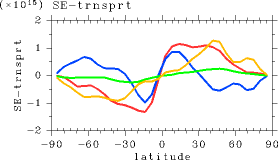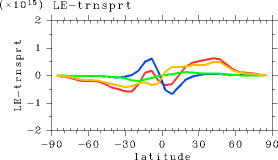Meridional Energy Transport in Experiment S1200
In experiment S1200, dry static energy transport is larger than
latent heat energy transport (Figure 1a, b). The distribution of dry
static energy transport shows that the magnitude of transport is
smaller than that in experiment S1380 but the contributions from
each component is similar. The magnitude of latent heat energy
transport is tenth smaller than that in experiment S1380 since
atmospheric water vapor contents largely decreases. The equatorward
transport is remarkable in the low latitude region from 20 latitude
north and south, and the poleward transport is remarkable in the
high latitude region. Due to this characteristics, there are two
peaks in the total transport profile. Comparing to the result in
experiment S1380, the contribution by meridional mean circulation is
larger. Unfortunately, the difference between the result in
experiment S1200 and that in experiment S1380 has not yet been
examined.
(a)  |
(b) 
|
|
Figure 1:Meridional energy transport in experiment
S1200 (W). (a): Meridional dry static energy transport. (b):
Meridional latent heat energy transport. Red: total transport. Blue:
transport by the mean meridional circulation. Green: transport by
stationary disturbances. Light brown: transport by transient
disturbances. |

